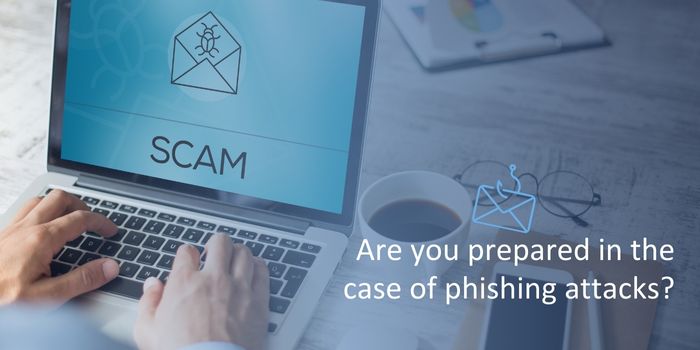Picture this scenario: an employee receives an email that conveys urgency, purporting to be from their bank and warning of suspicious account activity. Fueled by panic, they click a link and unwittingly provide login credentials to a cybercriminal. This is the stark reality of phishing attacks, a sophisticated email scam wreaking havoc on businesses of all sizes.
Beyond Financial Loss: The Widespread Impact of Phishing
The ramifications extend further, causing operational chaos when critical systems are compromised, data is locked down, and employees are left scrambling. Productivity plummets, deadlines are missed, and the IT team works tirelessly to contain the damage. The ripple effect touches every department, impacting sales, marketing, customer service, and finance.
Moreover, phishing attacks can result in intellectual property theft, with hackers gaining access to trade secrets, product roadmaps, or marketing strategies. This stolen information provides competitors with an unfair advantage, putting your entire business at a significant marketplace disadvantage.
Empowering Your Workforce: Creating a Human Firewall
The silver lining? The primary defense against phishing lies not in intricate technology but in the awareness and vigilance of your employees. Envision equipping them with the knowledge and skills to identify suspicious emails, URLs, and attachments. You can do this by conducting regular phishing training simulations that allow employees to show their preparedness in a realistic scenario. You can also provide ongoing training highlighting examples of phishing and the impact it can have as well as how the situation could be avoided. Empower them to become “phishing champions,” sharing their knowledge and reporting suspicious activity promptly.
Moreover, consider establishing a dedicated cybersecurity awareness program covering broader topics like password hygiene and secure browsing habits. Create a user-friendly reference guide or an online portal for quick updates on the latest phishing trends. Implement a mentorship system for employees to share cybersecurity insights and encourage open communication channels for reporting potential threats. This streamlined approach ensures your workforce remains vigilant without overwhelming them with excessive information.
Tech Solutions: Strengthening Your Defense
While employee awareness is paramount, technology plays a pivotal role in fortifying your defenses. Envision email filters and anti-phishing solutions acting as digital gatekeepers, automatically filtering out suspicious emails and blocking malicious links. Implement multi-factor authentication (MFA) as an additional layer of security, requiring a second verification step before granting access to sensitive accounts. This multi-pronged approach significantly reduces the likelihood of a successful phishing attack.
In tandem with these technological safeguards, consider adopting advanced threat intelligence systems that continuously monitor and analyze evolving cyber threats. These systems proactively identify potential phishing patterns, enabling a swift response to emerging risks. Regularly update and patch software across all organizational devices to address vulnerabilities that cybercriminals may exploit. Additionally, invest in employee training programs that provide insights into the latest technological advancements in cybersecurity, ensuring that your workforce remains well-informed and adaptive to the ever-changing threat landscape. By combining cutting-edge technology with a knowledgeable and alert workforce, your organization can establish a robust defense against the dynamic challenges posed by phishing attacks.
Preparing for the Unavoidable: The Significance of an Incident Response Plan
Even with robust defenses, breaches can occur. What then? A well-defined incident response plan can make all the difference in minimizing damage and ensuring a swift recovery. Picture a plan outlining roles, responsibilities, and clear steps for data breach notifications, crisis communication, and system recovery. Regular testing and updates are essential to ensure its effectiveness against evolving threats.
Moreover, consider incorporating a designated incident response team comprised of individuals with expertise in cybersecurity, legal affairs, and public relations. This interdisciplinary approach ensures a comprehensive and well-coordinated response to any security incident. Conducting simulated exercises regularly with this team enhances their readiness, allowing for a seamless and efficient response when a real threat arises. Additionally, establish communication protocols with relevant external entities, such as law enforcement and regulatory bodies, to facilitate a swift and compliant response. Your incident response plan forms the basis of how you respond to cyber threats and threat actors, and should be open to change based on the ever moving nature of technology. This doesn’t, however, mean your plan should be changing day-to-day. Instead it means that you should be prepared to evaluate changing dynamics and challenges and use that information to better inform and update your plan in order to avoid inevitable cyberattack.
A Collective Effort Against Phishing
The battle against phishing goes beyond individual companies. Envision a world where everyone is aware of the dangers and takes steps to protect themselves. Spearhead awareness campaigns within your community, educate friends and family, and support initiatives promoting online safety. Through collective efforts, we can create a safer online environment, reducing risks for everyone.
Building a Phishing-Resilient Future
Phishing remains a persistent threat, but it is not insurmountable. By empowering your employees, implementing robust technical safeguards, and having a well-defined plan in place, you can significantly reduce vulnerability. Remember, vigilance is key. Share knowledge, stay informed, and collaborate to create a future where businesses and individuals navigate the digital world with confidence, free from the fear of digital phishing.

